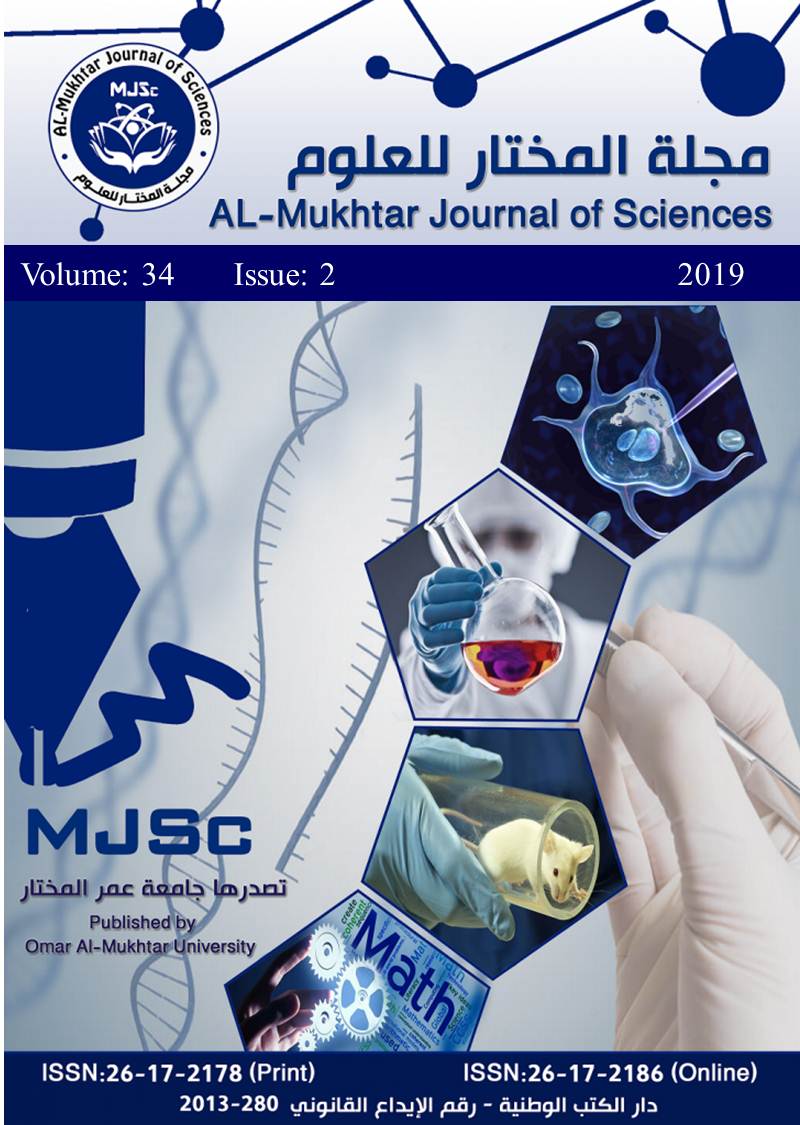Morphological variation of Libyan carob (Ceratonia siliqua L.)
DOI:
https://doi.org/10.54172/mjsc.v34i2.77Keywords:
Carob, Ceratonia siliqua, morphological traits, genetic variationAbstract
Carob tree Ceratonia siliqua L., is an evergreen endemic species found naturally in El-Jabal El-Akhdar region which is located immediately south of the coastal belt in the northeastern region of Libya. Morphological characteristics have been the main descriptive tool to characterize a given collection or germplasm, or to identify and differentiate wild type populations. Eighteen carob population were collected from six different sites in El-Jabal El-Akhdar area. Seven characters on discriminative pods were measured: the length, width, thickness, number of seeds, weight of pulp, and yield as well as one character to seeds: the weight seeds. The present study showed that the choice of pod characters to assess Libyan carob diversity is a useful and powerful tool. The means and standard deviations of morphometric characters measured in Libyan carob showed highly significant differences among the studied populations for all the examined characteristics. Differences in morphometric traits of carob pods and seeds among Libyan carob populations are primarily caused by genetic factors. The pod size of Libyan carob is considered to be the medium size (10.89 – 17.55cm).
Downloads
References
Albanell, E., Caja, G., & Plaixats, J. (1991). Characteristics of Spanish carob pods and nutritive value of carob kibbles. Options Mediterraneennes. Serie A: Seminaires Mediterraneens (CIHEAM).
Barracosa, P., Osorio, J., & Cravador, A. (2007). Evaluation of fruit and seed diversity and characterization of carob (Ceratonia siliqua L.) cultivars in Algarve region. Scientia Horticulturae, 114(4), 250-257.
Batista, M., Amaral, M., & Proença Da Cunha, A. (1996). Carob fruits as source of natural oxidant. Paper presented at the Proceedings of the Communication in Third International carob Symposium, Tavira, Portugal.
Battle, I., & Tous, J. (1997). Carob tree: Ceratonia siliqua L.-Promoting the conservation and use of underutilized and neglected crops. 17: Bioversity International.
Correia, P., & Martins-Loucao, M. (1994). Preliminary studies on Mycorrrhizae of Ceratonia siliqua L. New York Botanical Gardens: Mycorrhizas in integrated systems from genes to plant development. NY Bronx, 86-88.
El Kahkahi, R., Zouhair, R., Ait Chitt, M., & Errakhi, R. (2014). Morocco carob (Ceratonia siliqua L.) populations: Morphological variability of Pods and Kernel. Int. J. Pure App. Biosci, 2(4), 38-47.
Elfazazi, K., Jbilou, M., Assaidi, A., Benbati, M., & Harrak, H. (2017). Morphological and Biochemical Variability of Moroccan Carob (Ceratonia siliqua L.) Produced in Beni Mellal Region. Int. J. Pure App. Biosci, 5(4), 14-21.
El-Zwaam S.M. (1995). El-Jabal El-Akhdar (In Arabic). Garyounis University, Benghazi, Libya
Gharnit, N., Et Mtili, N., Ennabili, A. T., & Ennabili, A. (2001). Social characterization and exploitation of carob tree (Ceratonia siliqua L.) from Mokrisset and Bab Taza (NW of Morocco). Sci. Lett, 3(2), 1-10.
Johnson, D. L. (1973). Jabal Al-Akhdar, Cyrenaica: an historical geography of settlement and livelihood: University Press.
Kahkah, E. R., Zouhair, R., Diouri, M., Ait Chitt, M., & Errakhi, R. (2015). Morphological and biochemical characterization of Morocco carob tree (Ceratonia siliqua L.). Int J Biol Med Res, 6(2), 4946-4952.
Konaté, I., Filali-Maltouf, A., & Berraho, E. B. (2007). Diversity analysis of Moroccan carob (" Ceratonia siliqua" L.) accessions using phenotypic traits and RAPD markers.
Lo Gullo, M., & Salleo, S. (1988). Different strategies of drought resistance in three Mediterranean sclerophyllous trees growing in the same environmental conditions. New phytologist, 108(3), 267-276.
Marakis, S., Kalaitzakis, J., & Mitrakos, K. (1988). Criteria for recognizing carob tree varieties. Paper presented at the Proceedings of the II International Carob Symposium (P. Fito and Mulet, eds.) Valencia, Spain.
Naghmouchi, S., Khouja, M., Romero, A., Tous, J., & Boussaid, M. (2009). Tunisian carob (Ceratonia siliqua L.) populations: Morphological variability of pods and kernel. Scientia Horticulturae, 121(2), 125-130.
Ramón-Laca, L., & Mabberley, D. (2004). The ecological status of the carob-tree (Ceratonia siliqua, Leguminosae) in the Mediterranean. Botanical Journal of the Linnean Society, 144(4), 431-436.
Sharaf, A. T. (1971). Geography of Libya. Alexandria, Egypt, Monsha’at Al Ma’aref, 247.
Sidina, M. M., El Hansali, M., Wahid, N., Ouatmane, A., Boulli, A., & Haddioui, A. (2009). Fruit and seed diversity of domesticated carob (Ceratonia siliqua L.) in Morocco. Scientia Horticulturae, 123(1), 110-116.
Srečec, S., Kremer, D., Karlović, K., Peremin Volf, T., Erhatić, R., Augustinović, Z., . . . Dunkić, V. (2016). Comparison of Morphological Characteristics of Carob Tree (Ceratonia siliqua L.) Pods and Seeds of Populations Collected from Two Distant Croatian Islands: Drvenik Mali and Mali Lošinj. Agriculturae Conspectus Scientificus, 81(1), 61-64.
Tous, J., Olarte, C., Truco, M., & Arús, P. (1992). Isozyme polymorphisms in carob cultivars. HortScience, 27(3), 257-258.
Tous, J., Romero, A., Plana, J., & Batlle, I. (1996). Current situation of carob plant material. Paper presented at the Proceedings of the III International Carob Symposium. Cabanas-Tavira. Portugal
Downloads
Published
How to Cite
License

This work is licensed under a Creative Commons Attribution-NonCommercial 4.0 International License.
Copyright of the articles Published by Almukhtar Journal of Science (MJSc) is retained by the author(s), who grant MJSc a license to publish the article. Authors also grant any third party the right to use the article freely as long as its integrity is maintained and its original authors and cite MJSc as original publisher. Also they accept the article remains published by MJSc website (except in occasion of a retraction of the article).










